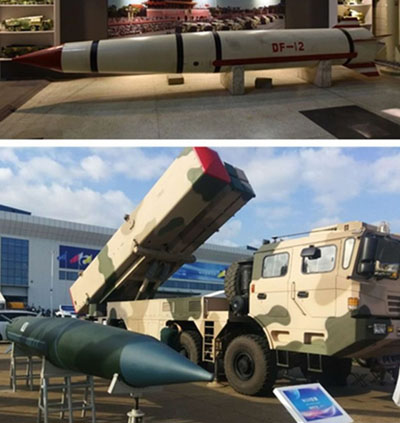by WorldTribune Staff, April 26, 2020
There is a high level of concern among U.S. officials that China may be preparing to resume nuclear testing, an analyst noted.
Furthermore, the United States must take emergency action to fill the strategic “gap” with China that has widened, he warned.

China conducted its last full nuclear device test on July 29, 1996 and nearly two months later, on Sept. 24, 1996, signed the Comprehensive Nuclear Test Ban Treaty (CTBT), Richard Fisher noted in an April 21 analysis for Geostrategy-Direct.com.
Like the United States, China adheres to the treaty but has not formally ratified it.
However, in mid-April 2020 the U.S. State Department released its latest “Compliance Report,” which assess the degree to which other suspect countries have complied with the CTBT and other nuclear and missile technology sale control agreements.
Regarding China it stated:
“China maintained a high level of activity at its Lop Nur nuclear weapons test site throughout 2019. China’s possible preparation to operate its Lop Nur test site year-round, its use of explosive containment chambers, extensive excavation activities at Lop Nur, and lack of transparency on its nuclear testing activities – which has included frequently blocking the flow of data from its International Monitoring System (IMS) stations to the International Data Center operated by the Preparatory Commission for the Comprehensive Nuclear Test-Ban Treaty Organization – raise concerns regarding its adherence to the “zero yield” standard…”
U.S. critics of the report contend that China could also be conducting “sub critical” nuclear testing at Lop Nor, or test components of nuclear weapons that also result in a “low yield” nuclear measurement.
In an April 25 analysis for The Diplomat, Fisher wrote that “Prior to the COVID-19 global pandemic, President Donald Trump made clear his intention to engage China and Russia to seek new agreements limiting theater- and intercontinental-range nuclear missiles.”
The Chinese Communist Party (CCP) leadership’s “long-standing refusal to join nuclear limitation negotiations, its People’s Liberation Army’s (PLA’s) current overwhelming superiority in theater nuclear and nuclear capable systems, and its broad investments in new intercontinental nuclear systems and new strategic missile defenses, require that Washington also place a high priority on developing new strategic nuclear capabilities and making additional investments in missile defenses to counter this aggression,” Fisher wrote.
There is a “good chance that China is seeking nuclear parity, if not superiority, versus the United States. Yes of course, China regularly denies that it seeks a large strategic nuclear force. But perhaps such statements, combined with China’s abhorrence of nuclear transparency, reflect its deeper history of strategic deception,” Fisher wrote.
China’s “achievement of decisive superiority in theater nuclear-capable missiles, about 1,800 to 2,000 systems, helped the Trump administration withdraw from the 1987 Intermediate Nuclear Forces (INF) Treaty with Russia,” Fisher noted.
The PLA Rocket Force (PLARF) now has the precision land-attack and anti-ship capable, 4,000-kilometer range Dong Feng (DF)-26 and the 2,000-km range DF-17, the world’s first maneuverable anti-missile evading Hypersonic Glide Vehicle (HGV) armed theater missile.
Defense Intelligence Agency Director Lt. Gen. Robert P. Ashley’s May 30, 2019 statement at the Hudson Institute that China could over the next decade “double the size of its nuclear stockpile,” which could reach about 600 nuclear warheads, is regarded as an overestimate by some analysts.
“But this could be an underestimate considering the variety of new intercontinental missiles now being deployed or developed,” Fisher noted.
The PLARF may have three six-missile brigades of the liquid-fueled silo-based DF-5 intercontinental ballistic missile (ICBM), with perhaps two brigades with the three-warhead DF-5B. Meanwhile the 10-warhead DF-5C is in development but could be succeeded by a silo-based version of the solid-fueled 10-warhead capable DF-41. A road-mobile version of the DF-41 may already equip multiple brigades and a rail-based version is also under development.
The PLA Navy (PLAN) is reported to have tested its new, potentially multiple warhead capable, JL-3 submarine-launched ballistic missile (SLBM). And sometime in the mid-2020s, the Xian H-20 flying-wing strategic bomber will complete the PLA’s “strategic triad.”
“At the same time as this Chinese missile buildup, America’s nuclear forces and missile defenses are in flux,” Fisher wrote.
“The Pentagon has committed to developing the Next Generation Interceptor (NGI) to counter ICBM threats, but this will not be an active missile defense system until at least 2026, and some experts estimate it may not be operational for as many as 12 years. This leaves a strategic capability gap,” he continued.
Therefore, Fisher concluded, it is “crucial to fund current theater and strategic missile defense programs to fill the gap while the NGI is being developed.”
Interceptors such as the Navy’s SM-3 and SM-6 missiles, systems such as Aegis Ships and Aegis Ashore, and an extended-range version of the Theater High Altitude Area Defense (THAAD) system are all examples of proven, cost-effective technologies that the United States can procure now to counter current threats while simultaneously investing in technological advances to meet growing long-term demand.
Such commitments will be essential to meet China’s nuclear challenge and convince Beijing to finally consider verifiable nuclear limitation agreements. Congress and the Trump administration must ensure funding for them when the time comes for post-coronavirus U.S. defense spending adjustments.
Intelligence Brief __________ Replace The Media
